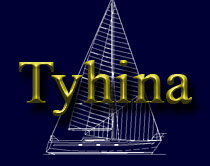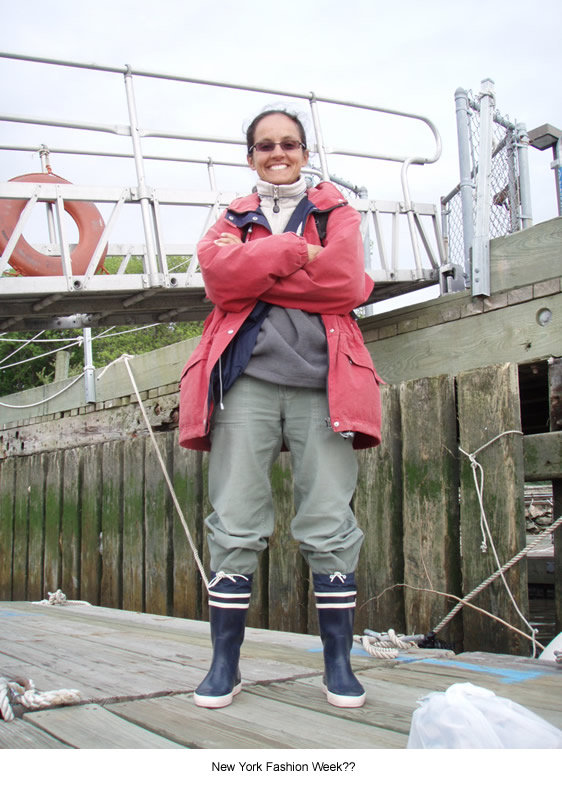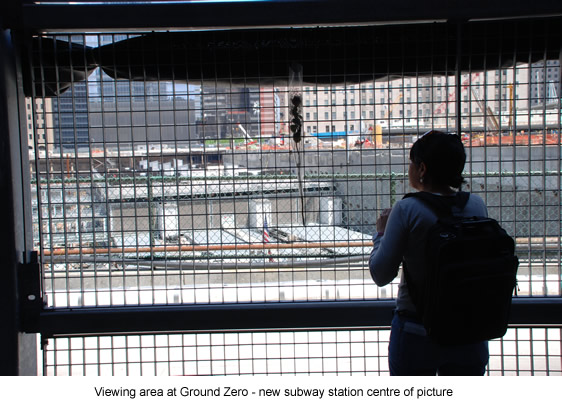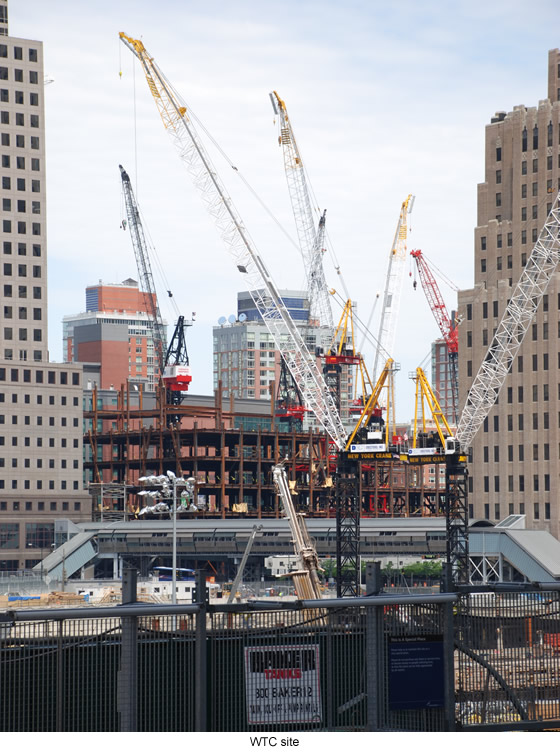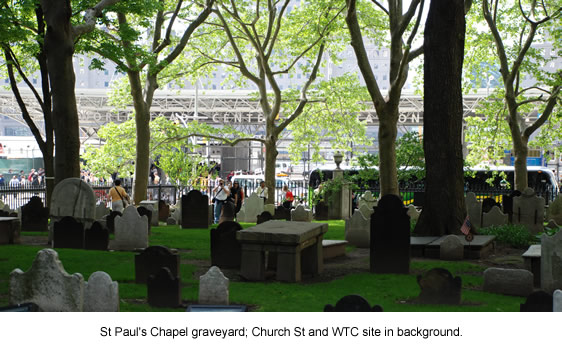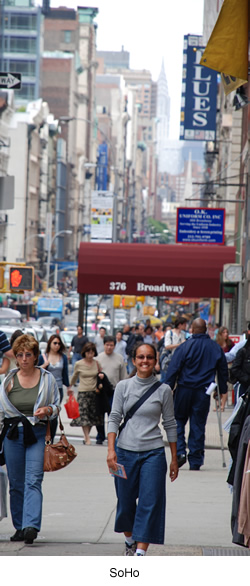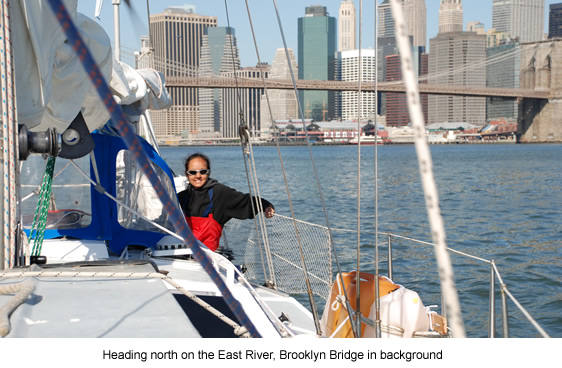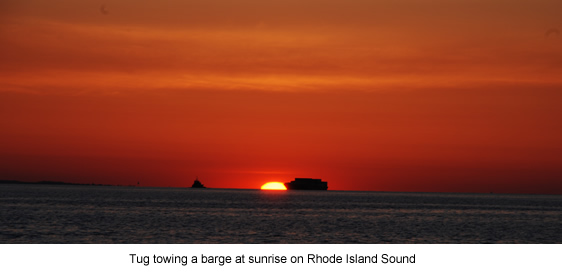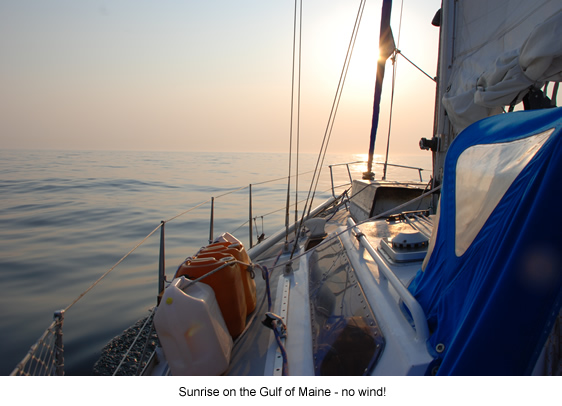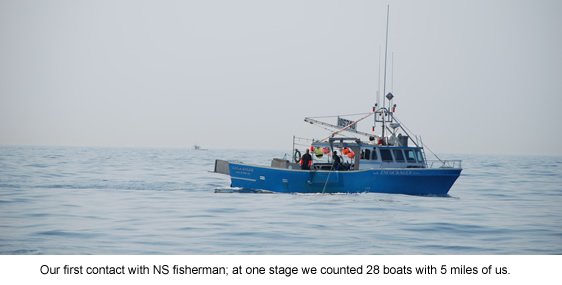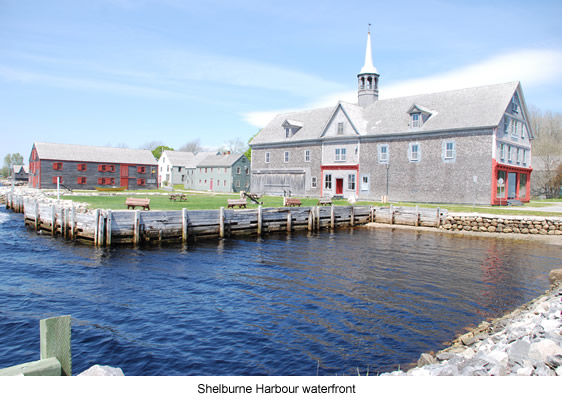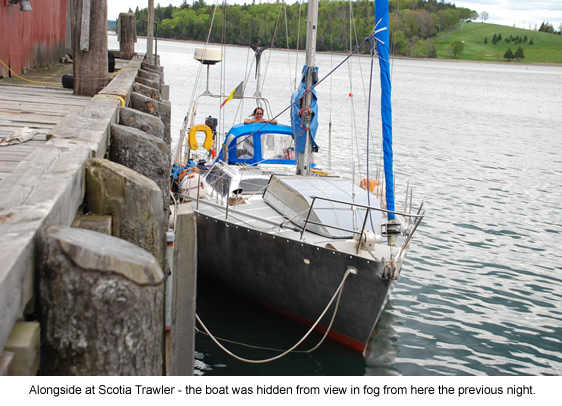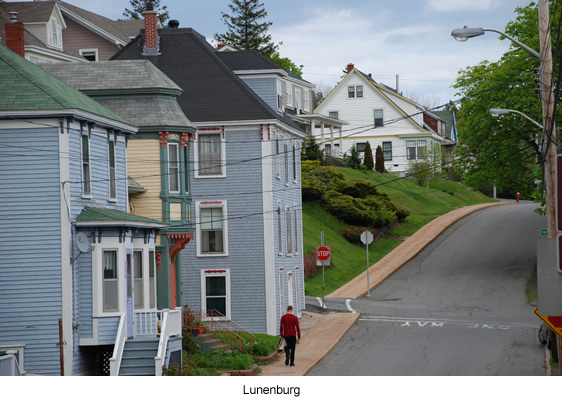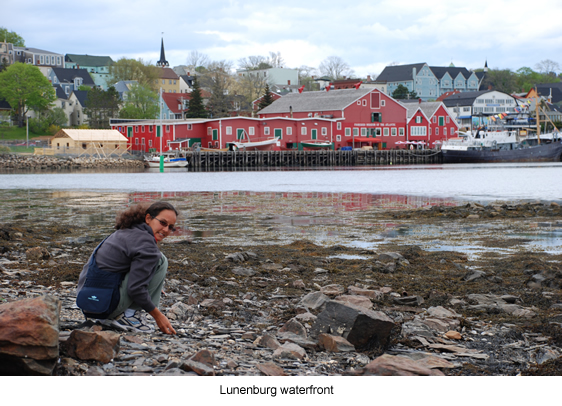Hello,
Since arriving in Canada during the night of the 25th of May, we have been busy preparing Tyhina for the Arctic. The task takes most of our time and a lot of our energy, hence the lack of news since New York. But here I am again, ready to fill you up with our adventures since our last report.
New York… New York…
Overall, we spent 4 days in New York: one to recuperate from our travel, two to run errands and do some research for the boat. The last one was spent playing tourist in the Big Apple, although running around NY to source new gear was also quite touristy and pleasant, I must admit. That’s if one can withstand the torture of walking through NY’s fashion district in one’s sailing jacket (a piece of equipment usually brightly colored!) on a clear mission to find the nearest shipshandler before it closes its doors (meaning no time for window browsing)! But then, I’ve never been much of a fashion victim! Still, I must report that rubber boots seemed to be the new trend in town, just not navy blue (the only colour I had on board!) so I can’t claim to have initiated the trend. |
We made the most of our ‘tourism’ day in NY. We left with no plan, ended up getting very sore legs but a good vibe from the place! A night at the New York Ballet for the culture, the absolute magic of the dancers… and after we stumbled upon half-priced tickets! A walk down ‘memory lane’ in Central Park which I first visited as a little girl with my mum and dad, a day after John Lennon was murdered. It was such a landmark event at the time that it was announced by the crew on our Air France flight as we landed at JFK. I must admit though that the park’s squirrels were a lot more interesting to me at the time. A visit to Wall Street, as would any MBA graduate! A walk through busy Chinatown and colorful Soho for the fun. And a visit to Ground Zero, for… well, I guess because unfortunately it is likely to be the cornerstone event that will define our generation. Just like our parents had Neil Armstrong and his walk on the moon, the Vietnam war and the Beatles. Well… and de Gaulle!
I am struggling to find the words to describe Ground Zero. I guess I was expecting a sad and somehow daunting place, but we walked around a construction site surrounded by tourists’ attractions. In fact, it was even quite a pleasant moment under clear sky and warm sun. I guess it is an amazing sign of human resilience that we can turn such a tragic place into a site of both remembrance, acknowledgement and hope for a better future. Yet I question the entrepreneurial spirit of those guys who walk among visitors trying to sell 9/11 picture souvenir kits
Strangely the reality of what New Yorkers went through on that day and the months after only hit us when we walked past St Paul’s Chapel on Broadway. Built in the 1760s, St Paul’s is Manhattan’s oldest public building in continuous use, and its only pre-Revolutionary church. And because George Washington was a regular there, we decided to have a closer look. What we had not realized (although it’s obvious on the map!) is that St Paul’s Chapel is on the other side of Church Street from the WTC site. It’s both troubling and touching to think that while the tall buildings were falling down, this tiny little stone building valiantly stood its ground against evil. In the days, weeks and months after 9/11, it became a rallying point for volunteers trying to escape for a few hours their gruesome recovery and then cleaning tasks at Ground Zero, as well as for New Yorkers in search of hope in the middle of madness.
The building now holds an exhibition of pictures and memorabilia from that period. One picture particularly struck us. It shows the Chapel’s graveyard on 10/11, its grave stones covered with debris from the towers, little guardians of another time standing in the day-after’s dusty light. |
New York to Newport, RI
We left our mooring at the 79th St Yacht Basin early Monday 21/06 with the outgoing tide (at around 3 knots, that’s something to keep in mind!) and motored down the Hudson River and up the East River catching the incoming tide as we turned the corner. We slalomed around the many ferries, past under the mythical Brooklyn Bridge, gawped at the size of the local jail and the sewerage plant (that’s the ‘other side’ of the Big Apple, the one that tourist guides don’t talk about) and watched planes take off from JFK and fly just above our mast (or so it seemed!).
As we left NY behind us, the landscape quickly changed. ‘Old money’ mansions with a nautical feel and green lawns replaced the city’s densely populated high rises. Good bye New York, welcome to Long Island and Rhode Island.
It took us a day and a night to motor from NY to Newport, RI. For those of you wondering (considering the many times we’ve talked about motoring), no we haven’t changed Tyhina into a trawler, there was just no wind.
Newport, RI is just one of those places where you feel you’re going to stumble across the Kennedys, except they’d be driving a Hummer. With a harbour full of beautifully varnished elegant cutters and brand new modern yachts (but nothing in between!), there is definitely a nautical feel about the place. Maybe we didn’t stay long enough to appreciate the place (sorry Newporters, we’re on a mission here!), maybe it was the bus driver abusing us because we didn’t have the exact change (sorry, but no one at the Tourism Office mentioned that the local buses had a ‘no change’ rule), or maybe again it was the two locals who sent me on a hike to a supermarket that was long gone (these people obviously have forgotten the value of walking), but to me, Newport, RI had this annoying ‘just a pretty face’ feel about it. Or maybe it was just that this was our last American stop before heading to Canada and truth must be said, by that time, we couldn’t wait to get there… |
Finally on our way to Canada
On Wednesday 23rd May, we finally cleared US Customs… quite a non-event since all we had to do was call the local Customs office to tell them we were leaving. This time, we managed to actually sail past Martha’s Vineyard and through Nuntacket Sound before the wind went walkabout on us again and we had to let our beloved Yanmar 22HP take over.
The 3-day crossing went as smoothly as one could hope, until the last few hours… As we were lazily enjoying the sun (all the same wearing thermal and polar fleece) leaving the hard work to Bob (one of our auto-pilots, the other one is called Jim), our little Yanmar started spluttering like a sick duck. Pete and I looked at each other for a fraction of a second before he flew down the stairs to open the fuel tank, shouting : “Get a jerry! Quick!” In what seemed like the very same second (OK, maybe it was 5 seconds!), I threw a 5-liter jerry that we had been given in Newport and was in the cockpit, before jumping on deck to get one of the big jerries we keep there. But too late, little Yanmar had taken a mouthful of air and went on strike. The sudden silence was both comforting (try to live, eat and sleep for 3 days next to a running engine and you’ll understand!) and unsettling (consider filling a tank without spilling fuel everywhere and then bleeding an engine on moving ground and you’ll understand!). And as Murphy’s law would have it, as the engine died, the wind came up, except right in our nose, and the fog came down, suddenly hiding both the stretch of Canadian coast we had been following and the many lobster pots left by fishermen in the area. Here’s how the next few minutes went…
(Both on deck)
Peter (captain tone): OK, I’m going to have to bleed the engine and then try to start it again. We’ll put some sail up and you’ll just have to steer us out of here.
Maeva (Well-I’m-not-the-one-who’s-going-to-bleed-the-engine tone): OK.
A few minutes later… (Peter in cabin, Maeva on deck)
Maeva (I-think-I-should-ask-the-question-sooner-rather-than-later tone): Do you have a bearing for me? Like, you know, that would help…
Peter (I’m-bleeding-the-bloody-engine tone): Away from shore and not into one of those pots
Maeva (Dude-where’s-the-shore tone): Well, that’s the thing, I can’t see anything…
Peter (Don’t-talk-to-me-when-I’m-bleeding-the-bloody-engine): What do you mean you can’t see anything?
Maeva (Dude-what-do-you-think-I-mean tone): We’re surrounded by fog.
Peter (I-can’t-believe-this tone): We’re what?!
A few minutes later… (Peter back on deck)
Peter (captain tone): OK, here’s your bearing… (Maeva expertly changes course) Right, we’re good now. Just watch out for those lobster pots… … … I said, just watch out for those pots…
Maeva (ooppsss-I’ve-gone-the-wrong-way tone): yeah yeah
Peter (CAPTAIN tone): WATCH OUT!
Maeva (did-I-really-go-the-wrong-way tone): where?
Peter (did-you-really-ask-that-question tone): there! THERE! Don’t you see it?
Meava (what-do-you-think tone): No, I don’t! I’ve got water on my sunglasses! Take the tiller for a minute, will you?
Peter (THINKING – while grabbing the tiller and just avoiding a pot): Then why are you steering if you can’t see a thing through your glasses?
Maeva (THINKING – while running down to the cabin to clean her glasses): Because you asked me to!
(For the record, this is really what we thought about at the time… a bit like mind talking, isn’t it? Must be married life doing that!)
Anyway, after these first few confusing minutes (going from lazily sunbaking in the cockpit to realizing we’re against wind and current in the fog near shore with no engine), we quickly got into action mode. Peter bled the engine and got it started again, while I kept Tyhina in clear waters. The wind quickly died, but the fog got thicker.
And in the fog somewhere… must be Nova Scotia
We had been warned by a few Canadian yachties: “If you can’t navigate with your instruments, then don’t go to Nova Scotia!” and sure enough, we hardly saw anything of Nova Scotia until we were close to anchoring in front of the Shelburne Harbour Yacht Club. But as strange as it may sound (and especially for someone who hates night), I really enjoyed our navigation in the fog. Without even discussing it, we quickly settled into clear roles: Pete out in the cockpit, steering and watching for marks and lobster pots, and me, down below at the nav station, watching radar and GPS, plotting our course on the chart every 10 minutes or so and giving new bearings to Pete as required. While I announced all the marks and was able to determine when we should reach each, we heard a few (those with fog signals) but didn’t see any. Yet, we know we were very close to a few of them… that’s how thick the fog was.
The funny thing about fog horns is that you never know who you’re talking to. When the fog first hit, we were still a couple of hours away from the entrance to Shelburne harbour, right in lobster pot land. And so when I started hearing fog horns, I diligently replied with our own horn, thinking I was somehow communicating with other human beings, probably on a fishing boat, poor souls like us navigating through white cotton. And so it went for a little while, sometimes I even felt we were having a conversation… That’s until we realized that those horns were coming to us very regularly… in fact as regularly as the fog signals marked on our charts. Yes, I was having conversations with buoys, not boys!
|
Shelburne, Nova Scotia
We smelt and felt Shelburne before we saw it, a mix of salty water, smoking fish and pine trees, and an overwhelming sense of calm, probably heightened by the lack of wind and waves that usually accompanies fog. And that’s how it will remain in my memory. Shelburne is a working fishing harbour, with a waterfront that has traveled from the 19h century so unscarred that it has starred in several historical films.
“Welcome to Shelburne founded in 1783 by United Empire Loyalists” says a road sign. Indeed, Shelburne was settled by Loyalists who retreated there from the American Revolution. At the time, Shelburne was one of the biggest towns in North America with 16,000 residents. Unfortunately (or maybe fortunately for us visitors today), the county didn’t have the natural resources to sustain such a township and the population rapidly dwindled to its present level of about 2,000.
Today, the waterfront streets have the charm and magic of a living museum. Most buildings date back to the town’s early days and show evidence of life, trade and industry from the Georgian period through to the Victorian. Yet it is a place where people live and work, While the Muir-Cox Shipyard, which in its glorious days served as a launch site for everything from square riggers and schooners to motorized rum runners, minesweepers and luxury yachts, is now a museum, the tiny Cooper’s barrels factory still produces barrels used to store salt bait and trawl lines… although I’m sure one day some trendy NY shop will sell these hand-made barrels as ‘nautical’ décor!
We were in Shelburne for 2 days, before heading towards Lunenburg… and its fog! |
Lunenburg, proudly Nova Scotian and Unesco world heritage site
Shelburne’s fog was really only a warm-up for the ‘real’ thing! Indeed, while the fog normally clears around Sandy Point, a mile away from downtown Shelburne (and it did for us), there is no such phenomenon in Lunenburg, so much so that the Lunenburg piers appeared on the radar a long time before we actually saw them. In fact, we only saw them when we were about 20 meters away! The entire approach, all the way to the actual docks, was done plotting our course on the chart from GPS data (we don’t have a plotter!) and confirming this with our radar. It was a bit worrying, yet I wouldn’t have had it any other way. As a few lights on the docks outlined the piers, some buildings and a fishing trawler, there was something both eerie and magical about the atmosphere and the strange feeling that what we were living right there would one day disappear.
The feeling was confirmed the following morning when we learnt that Scotia Trawlers, a well established and renowned service yard to the fishing fleet where we had hoped to have our engine serviced and buy sea-going long term food, no longer existed. The buildings are still there, guardians of another era, their size and footprint along the shore the last reminders of how big the fishing industry would have been in the area.
Lunenburg was built by the sea. It is everywhere, in everyone’s mind, eyes and discussions. The middle-aged fisherman who loads his lobster pots in his pick-up truck talks about the fishing season ending. The season had been good, he tells us, not as cold as other years. Of course, there was the fog, a few storms, the pots that sometimes got lost, the fishing quotas, those imposed on Canadian boats and those imposed on the American boats… A life of a Nova Scotian fisherman. And then there is the tall lady happy chappy in her art gallery on the main street. She tells us about going out for a little day sailing under the sun and how much more picturesque the coastline seems from offshore. The life of a semi-retired city-dweller turned art gallery owner.
Our walk from the fishermen’s dock to the Unesco world heritage main street’s art galleries and restaurants, feels like a walk through time, from the working Lunenburg slowly dying to the retirees hotspot. Don’t get me wrong, the change is certainly pouring some needed funds in the local economy. As retirees buy heritage houses and look after them as only full-time carers could, the town is absolutely gorgeous. And fish stocks most certainly could do with a break. But I guess for sea-going people like us, there would be something very saddening indeed to see a working waterfront change to car parks for tourist buses.
We left Lunenburg for Halifax on May, 31st, and I’ll tell you all about Halifax in my next report. |
